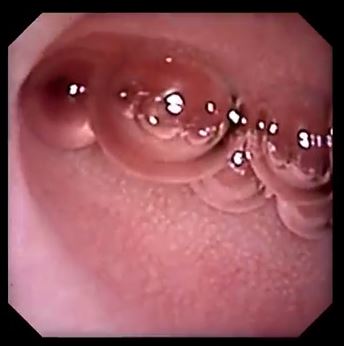Hysteroscopists have seen air bubbles disperse through the ostia intraoperatively and wondered whether this truly reflects tubal patency. This uncertainty has occurred in spite of using sonography (without hysteroscopy) to visualize air infused saline to assess tubal patency for over 30 years. Comparable supportive data for hysteroscopy has only been recently published and is called the Parryscope technique. (Parry, JMIG, 2017)
With hysterosalpingography, sonosalpingography, and hysteroscopic assessment, all techniques typically show open tubes to be open and closed tubes to be closed. Choosing one over another typically relates to not just familiarity, resources, and patient experience, but first and foremost accuracy relating to false positive and negative findings. When in 2013 we thought of using air infused saline at hysteroscopy to assess tubal patency, we had not heard of others doing it deliberately, and in searching the literature could not find references validating its use, mention of this approach in review articles for tubal patency, or any source discussing it at all.
Having a clean slate with which to explore the concept, we quickly found accuracy to hinge on a few things before performing an initial trial. These insights centered around the principle that pain induces tubal spasm (or technically uterine spasm around the tube), so the gentler the technique, the easier it would be to avoid false positives where air did not disperse through a patent tube owing to spasm.
Performed in this fashion, one can have 98.3-100% sensitivity to tubal occlusion with 83.7% specificity when compared to laparoscopic chromopertubation. (Parry, JMIG, 2017) Additionally, the Parryscope technique is very gentle, with 54% of patients experiencing no discomfort, and 91% mild to no discomfort (typically less than that of a Pap smear or period). (Parry, F&S, 2017) The 8% of patients experiencing moderate, 0.9% severe, and 0.2% extreme discomfort almost universally had cervical stenosis, endometriosis with chronic pelvic pain, or other explanatory circumstances (such as an IBS flare at the time of hysteroscopy). By comparison, HSG had a relative risk of being 110 times more likely to cause extreme discomfort, with a p-value of one in one hundred trillion. Performed in this fashion, one can have 98.3-100% sensitivity to tubal occlusion with 83.7% specificity when compared to laparoscopic chromopertubation. (Parry, JMIG, 2017) Additionally, the Parryscope technique is very gentle, with 54% of patients experiencing no discomfort, and 91% mild to no discomfort (typically less than that of a Pap smear or period). (Parry, F&S, 2017) The 8% of patients experiencing moderate, 0.9% severe, and 0.2% extreme discomfort almost universally had cervical stenosis, endometriosis with chronic pelvic pain, or other explanatory circumstances (such as an IBS flare at the time of hysteroscopy). By comparison, HSG had a relative risk of being 110 times more likely to cause extreme discomfort, with a p-value of one in one hundred trillion.
Coupled with the technique being fast (with the average procedure less than five minutes) and that it can be done in the office with reusable instruments, it is convenient and can be cost-effective. Moreover, it can be combined with ultrasound for a systematic evaluation of female fertility in a single visit. If female fertility is primarily ovarian function, tubal patency, and uterine receptivity, one can combine hysteroscopic tubal patency assessment with sonographic antral follicle count, sliding sign, and uterine imaging to have a reasonably thorough sense of the core determinants of female fertility.